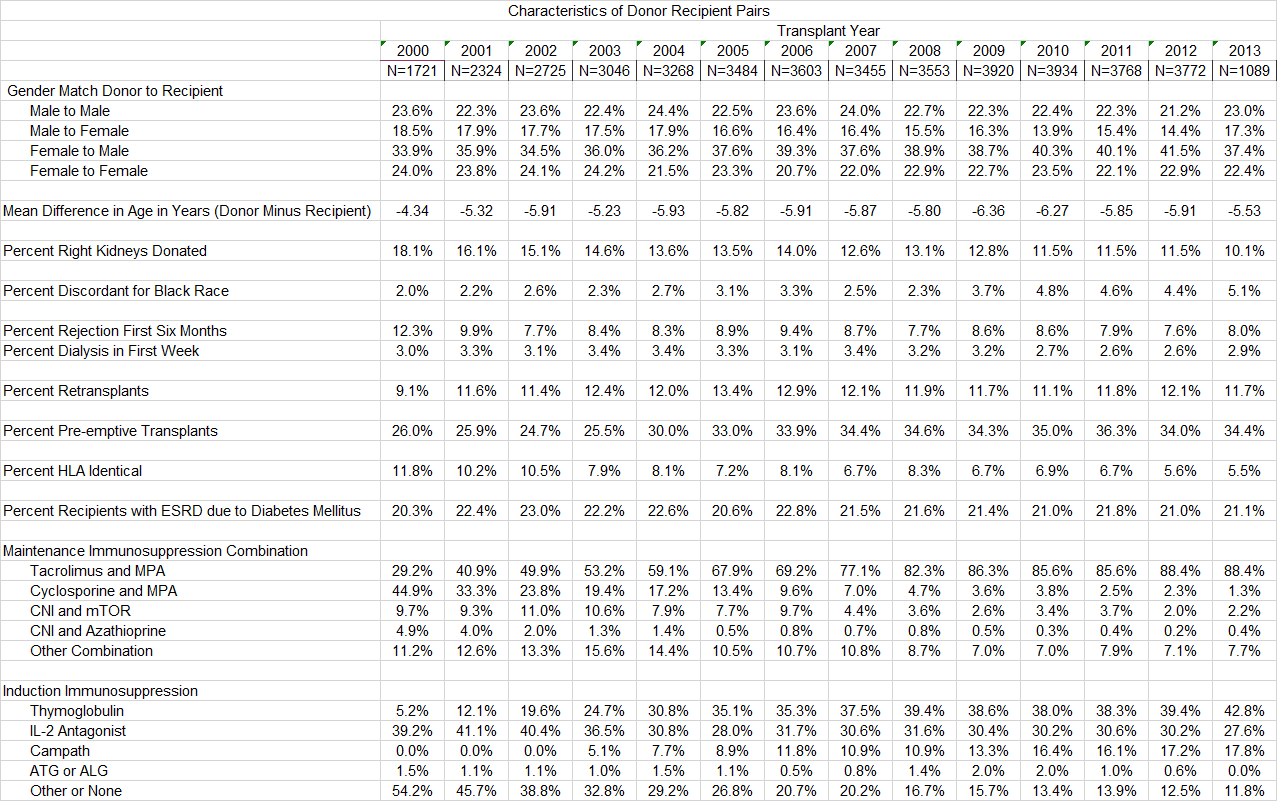Donor and Recipient Factors Important in Determining the Estimated GFR Difference Between Living Donor and Recipient Pairs Six Months After Transplant.
Medicine, Division of Nephrology, Sacred Heart Hospital, Pensacola, FL
Meeting: 2017 American Transplant Congress
Abstract number: D226
Keywords: Donation, Glomerular filtration rate (GFR), Kidney transplantation, Multivariate analysis
Session Information
Session Name: Poster Session D: Living Donor Kidney Transplant II
Session Type: Poster Session
Date: Tuesday, May 2, 2017
Session Time: 6:00pm-7:00pm
 Presentation Time: 6:00pm-7:00pm
Presentation Time: 6:00pm-7:00pm
Location: Hall D1
Analysis of the relationship between living donor and recipient estimated GFR (eGFR) six months after transplant revealed that in the first half of the last decade the difference in eGFR narrowed. Using the SRTR database 43,662 living donor and recipient pairs transplanted from January 1, 2000 until August 31, 2013 that had follow-up creatinines at six months for both the donor and the recipient were identified. Using the CKD EPI equation, the estimated GFR for the donor and recipient at six months after transplant were determined. Linear regression analysis of the cohort was used to identify factors important in determining the difference in eGFR. Table one shows the characteristics of the donor recipient pairs over the 14 year period. Although there were small changes in many of the variables over time, maintenance immunosuppression practices changed dramatically with tacrolimus and MPA derivative combination increasing from 29.2% of recipients in 2000 to 88.4% in 2013. All other combinations decreased. Induction therapy increased over the time period with Campath and Thymoglobulin having the most dramatic increases. The most significant factors determining eGFR difference were gender match, history of rejection in the first six months, history dialysis in the first week post-transplant, donor and recipient age difference and type of maintenance immunosuppression combination at discharge.
Although there were small changes in many of the variables over time, maintenance immunosuppression practices changed dramatically with tacrolimus and MPA derivative combination increasing from 29.2% of recipients in 2000 to 88.4% in 2013. All other combinations decreased. Induction therapy increased over the time period with Campath and Thymoglobulin having the most dramatic increases. The most significant factors determining eGFR difference were gender match, history of rejection in the first six months, history dialysis in the first week post-transplant, donor and recipient age difference and type of maintenance immunosuppression combination at discharge. Induction regimens only had a small impact on the difference with recipients without induction having slightly greater difference. Based on these findings the majority of the reduction in the difference in eGFR over the time period was due to the transition from other maintenance regimens to tacrolimus and MPA. Other factors like increased induction and changes in the demographics of donors and recipients played only a minor role.
Induction regimens only had a small impact on the difference with recipients without induction having slightly greater difference. Based on these findings the majority of the reduction in the difference in eGFR over the time period was due to the transition from other maintenance regimens to tacrolimus and MPA. Other factors like increased induction and changes in the demographics of donors and recipients played only a minor role.
CITATION INFORMATION: Keith D. Donor and Recipient Factors Important in Determining the Estimated GFR Difference Between Living Donor and Recipient Pairs Six Months After Transplant. Am J Transplant. 2017;17 (suppl 3).
To cite this abstract in AMA style:
Keith D. Donor and Recipient Factors Important in Determining the Estimated GFR Difference Between Living Donor and Recipient Pairs Six Months After Transplant. [abstract]. Am J Transplant. 2017; 17 (suppl 3). https://atcmeetingabstracts.com/abstract/donor-and-recipient-factors-important-in-determining-the-estimated-gfr-difference-between-living-donor-and-recipient-pairs-six-months-after-transplant/. Accessed December 26, 2025.« Back to 2017 American Transplant Congress
